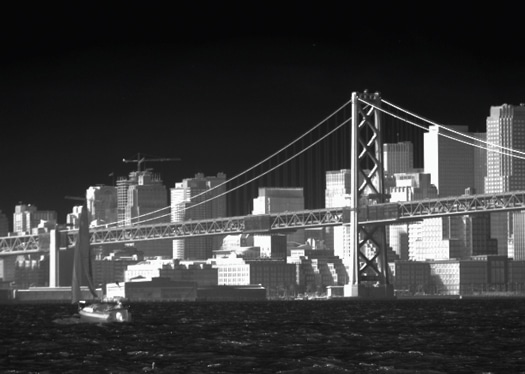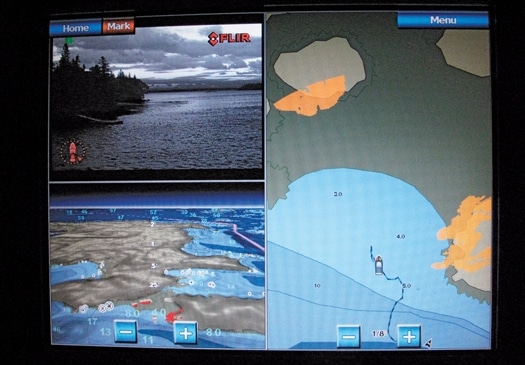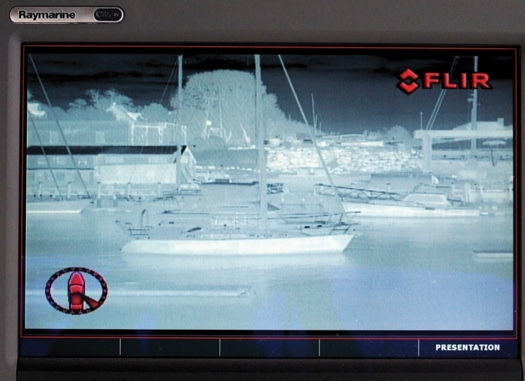
ytgjan26elec525.jpg
“Dark as a pocket” is how an old lobsterman I knew described the situation I chose for testing a FLIR M-636L thermal-imaging camera temporarily installed atop Gizmo’s antenna mast. It was a moonless night, with low clouds obscuring even star shine, and the uninhabited islands I cruised amongst offered no comforting shore lights. It was really dark. But the video image coming from the FLIR to an MFD set at near minimal screen brightness showed those dark shores in detail, plus the water’s surface-lobster pot buoys included- and even the clouds overhead, almost as if all were bathed in daylight. Well, make that a dull, monochrome daylight with some odd characteristics.
Thermal imaging, as offered by FLIR and other manufacturers, is brilliantly valuable to boaters in the dark, but it’s important to understand just where it fits in the wide category of “night vision.” Visible light occupies a tiny slice of the total electromagnetic radiation spectrum, with “infrared” an unusually wide slice just up from red in terms of increasing wave length. Therein lies confusion. Thermal cameras are often-and not incorrectly-called infrared cameras, but so too are significantly different vision aids like the Raymarine CAM100 that was also mounted on Gizmo that night. The latter is actually a conventional color video sensor that’s sensitive enough to image the particular infrared light that’s just beyond visible, plus it has a ring of special LEDs that can shine this so-called near-IR light on objects within close range. The result-aside from a terrific color daytime view into the distance-is a monochrome look at Gizmo’s cockpit and swim platform but not many feet farther. Keep in mind, an intruder wouldn’t know he was being seen, as those LEDs shine invisibly.
The infrared-assisted Cam100 ($700), and the many like it, are darn useful around a boat, but they can’t hold a candle, so to speak, to infrared thermal cameras like the FLIR M-636L ($20,000) and its brethren. The longwave- thermal portion of the infrared-wave band is totally unrelated to visible light or the digital cameras that can see it. Thermal infrared is instead related to the internal molecular heat of an object and is emitted by everything, including icebergs. The sensor that can feel it, called the core, is a very exotic bit of tech, and thus somewhat crude even at this price. In fact, the M-636L’s 640-by-480-pixel microbolometer core smashed a price barrier as other marine cameras in this range, and higher, had typically offered 320-by-240-pixel image resolution. Many of those competitor products have caught up now, often using a FLIR core. The quadruple resolution improvement is definitely noticeable, and increases the range at which a danger can be noticed and identified. But 640-by-480 is still low-res in modern video terms, and that’s one reason that many marine night-vision systems like the M-636L pair a conventional low-light video camera with the thermal sensor.

| | |
Another reason is that thermal cameras have trouble with water in the air, which absorbs thermal radiation and thus masks objects beyond. But the effect varies a great deal with the density of fog or rain. In my testing, the thermal camera revealed a coastline otherwise hidden by fog burning off late one morning. In heavy twilight rain, it lost an island half a mile away that I could make out with my eye and see quite well with the low-light camera.
In fact, there’s a lot of value to two or more cameras in the same case. Some manufacturers add full-color HD cams or the light-intensification technology that’s more commonly seen in night-vision monoculars. In the case of the FLIR M-636L, the low-light cam sometimes served well as elaborate binoculars, even if it couldn’t see beans in dark-as-apocket conditions. Meanwhile, the thermal cam showed daytime uses beyond seeing through “dry” fog, like when I was unhappily driving straight into a wide swath of sun glare until I realized that the FLIR microbolometer ignored that glare altogether, revealing pot buoys as well as it did at night.
Because that microbolometer can turn slight differences in radiated heat into monochrome video, things that are especially hot relative to a scene, like a human most anywhere, tend to stand out vividly. The default set the image to hot as white, but I found hot as black more “realistic” looking. Day or night, I could more quickly identify human activity around my harbor with the thermal camera than with any other form of vision aboard. This, and the fact that thermal cameras can also track hot objects like exhaust pipes well, is why they caught on first for security and military uses, and hence why the performance of the M-636L is slightly, if artificially, throttled.
Because of the FLIR microbolometer’s relatively high resolution, the U.S. government insists that any system using it be limited to nine frames per second instead of the normal 30 frames, which their testing has deemed too powerful for civilian hands. Frankly, I found this slow refresh rate very hard to notice unless a boat passed close and quickly by, but it’s the sort of thing you might want to know before making a large thermal investment. Casings and controls are definitely worth thinking about, and I suspect the FLIR MSeries is a good reference design.

| | |
For one thing, the M’s bullet casing, only 11 inches tall and seven in diameter, lets the cameras freely rotate 360 degrees and tilt more than 90 degrees without bumping into anything. In other words, you can mount an M-636L under most open-array radars or alongside thin antennas if that’s what it takes to get the best crow’s nest view from your yacht. I also found the control unit’s variable speed puck and the on-screen graphic references just about right for pointing the camera’s 26-degree field of view where I wanted it. And using Ethernet to power and interconnect multiple controllers within a camera system makes for a tidy install and may pave the road for M-Series features not seen on the M-636L.
More features? While FLIR has redefined what’s possible in this price range, higher-end night-vision systems offer valuable integration with radar and AIS-like automated pan/tilt to a selected target- and desirable options like gyro stabilization (peering around from the crow’s nest while your stomach is in the pilothouse can be unsettling). One place to see what more money can buy is FLIR’s own Voyager Series (www.flir.com), but you should also check out OceanView Technologies (www.nightboating.com), NVTi (www.nvti-usa.com), and Current Corporation (www.currentcorp.com). While I suspect that we’ll be seeing continually better and less expensive thermal vision products for years to come-with FLIR often leading the charge-Current is working on new night-vision technology that will purportedly use timed laser illumination to see right through even heavy fog and rain. That might change the game.









